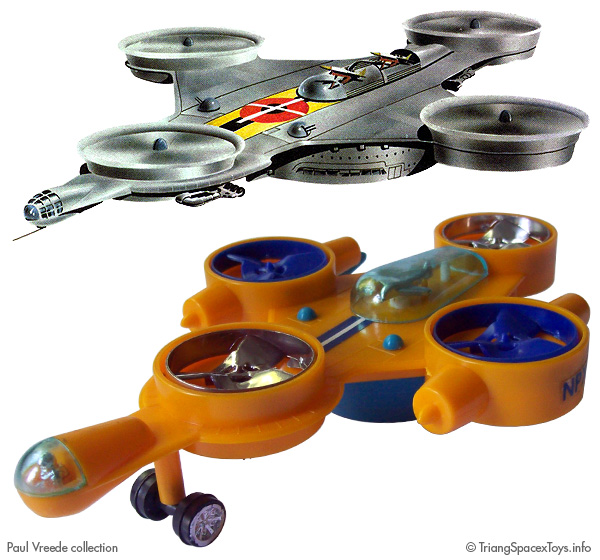
The Nuclear Pulse is the third Spacex design I found in the pages of my Dutch Thunderbirds Extra 2 annual from 1966 (and which others independently found in the original version in TV21 Summer Extra of the same year).
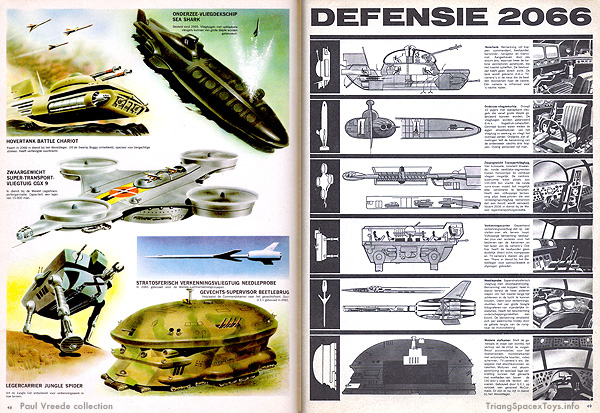
Appearing with the Needle Probe (qv) in the Defence 2066 article illustrated by Eric Eden, the Pulse is based on the Heavy Duty Super Freighter CGX 9. As the caption with the colour illustration explains, this is a "World Army Transport Command craft [which] carries enough equipment for [a] small army of 15,000 men." Judging by the size of the cockpit and vehicles in the technical illustration, this claim appears to be somewhat overstated. :)
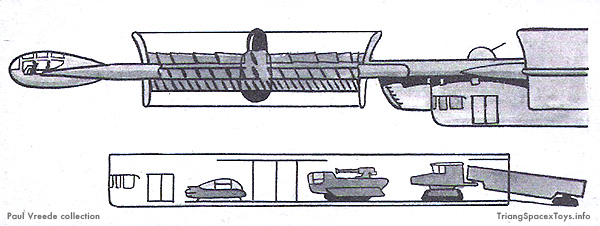
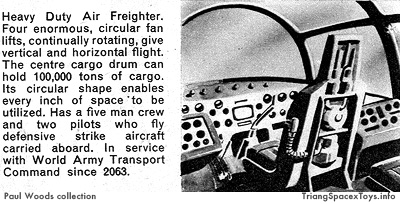
Aircraft with ducted-fan rotors were popular subjects in the more technical side of the popular press at the time, and served as suitably futuristic transport in comic strips as well.
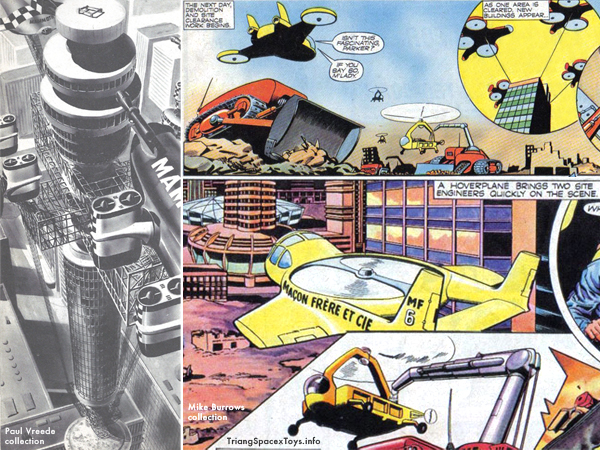
Above: more rotorcraft by Eric Eden, from various issues of TV21.
Below: Spirou learning to fly the iconic Zorglumobile, by André Franquin, 1960. (1)
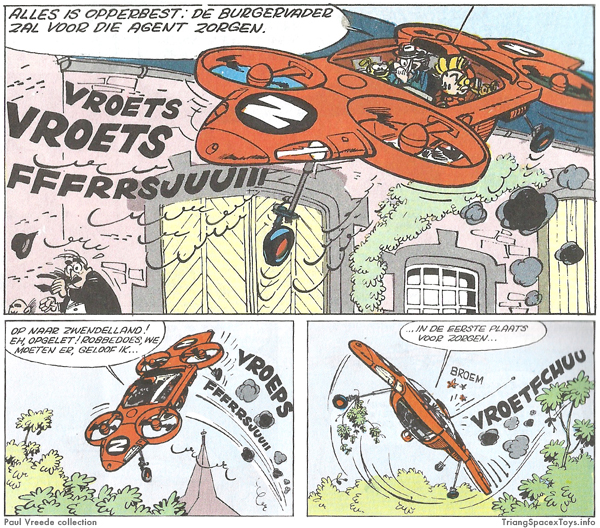
Inspiring all these fantastic visions of future transport was hard research carried out in the US. From the mid-1950s, various suppliers to the US military had been developing a number of rotary craft for various purposes - from transporting a single soldier to lifting heavy loads. (2)
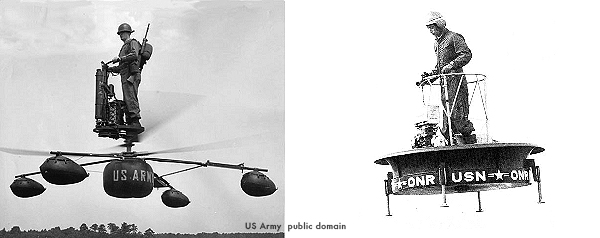
Above: the De Lackner HZ-1 Aerocycle (left) and Hiller VZ-1 Pawnee flying platforms.
Below: the amazing VZ-9 Avrocar, one of two flying saucer designs by Avro Canada.
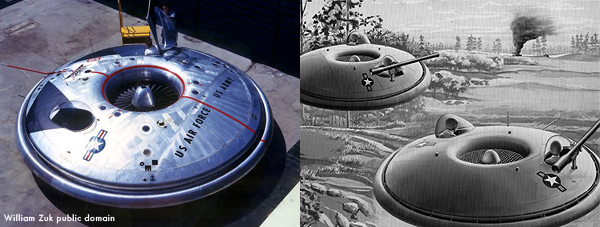
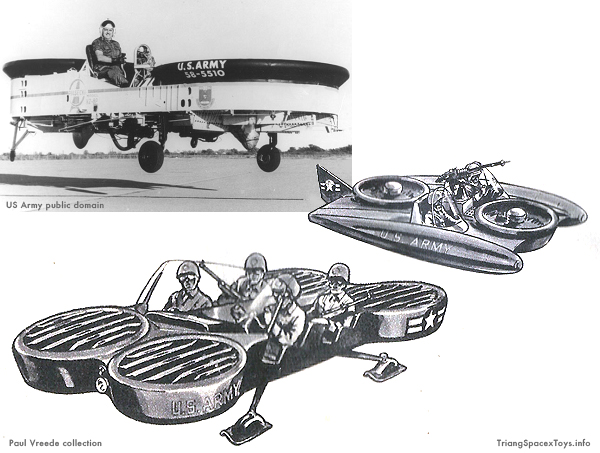
Above: the Piacecki VZ-8 Airgeep (photo) and two designs by Hiller Aircraft for flying jeeps.
Below: the civilian version by Hiller, on the cover of the German edition of Popular Mechanics in September 1957 (taken over from the July edition in English).
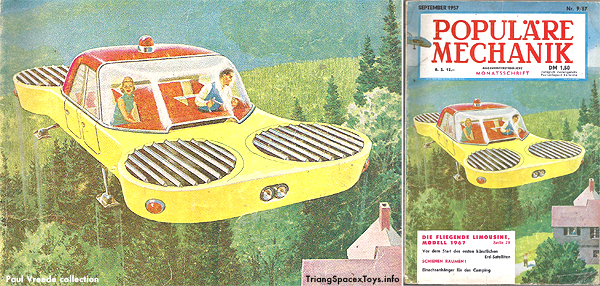
Most notable of these suppliers was Hiller Aircraft Corp, who had a knack of getting their concepts published in magazines such as Life, Popular Mechanics and its French equivalent Science & Vie (with the French version of Meccano Magazine (but not the British version) blatantly ripping off the Popular Mechanics cover for one of their own). The article in Popular Mechanics of 1957 (where the Hiller illustrations on this page are from) does a thorough job of describing the company's vision, and it is here too that I found the most likely inspiration for Eric Eden's Heavy Duty Freighter.
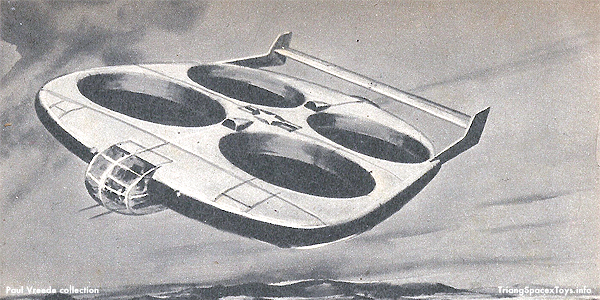
Above: a Hiller patrol craft that combines lifting rotors with jet propulsion.
Below: a Hiller flying crane with four ducted-fan rotors.
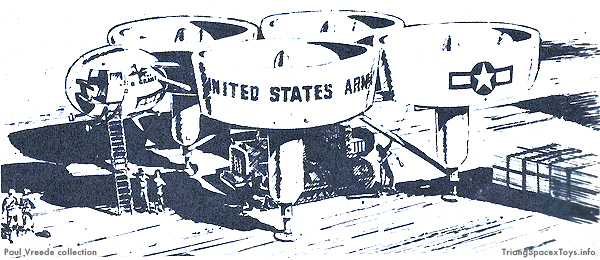
Although I've seen one other, less cropped version of this flying crane image, there doesn't seem to be any information on this particular design on the internet (though there is quite a bit on numerous other flying crane concepts from Hiller). The text in Popular Mechanics describes it as having fan ducts of 4.5 m / 15 ft diameter, making it not particularly fast (80 kph / 50 mph) but capable of lifting heavy cargo that fits under its tall undercarriage.
None of the ducted-fan aircraft above got any further than a few experimental evaluation examples, mostly for reasons of stability, poor performance and especially fuel consumption. With the advent of the jet-powered rotor, regular helicopters became powerful enough to lift heavy loads. Ducted fans gave way to various tilt-rotor aircraft designs (by major and smaller manufacturers including Hiller), which are a vast topic on their own.
Although ducted-fan aircraft are still being invented and developed to this day, it's the arrival of the small electric motor that has made model drones with quadruple rotors the most practical and effective result for this type of aircraft. (3)
External links open in new windows. Just close them to get back here.
1: André Franquin was I think the best Franco-Belgian comic artist of his time. Relatively unknown and unpublished in the english-speaking world, his comic strips (notably Spirou & Fantasio in the late 50s and 60s, Gaston Lagaffe and the very black-humoured Idées Noires) are well worth keeping an eye out for (there's plenty to find on Wikipedia about him if you follow the links to his work). Appearing in Spirou albums #15 "Z comme Zorglub" (scans from edition in Dutch) and #16 "L'ombre du Z", the Zorglumobile is one of his best-known machines, with a huge fan-following to this day. Have a Google image search and you'll find drawings, authorised models, 3D art and even RC models built by fans. back to text
2: if interested, Airvectors.net has more on flying platforms and jeeps,
while there's also more on Wikipedia, including the following machines:
De Lackner HZ-1 Aerocycle
Hiller VZ-1 Pawnee
Avro Canada_VZ-9 Avrocar
Piasecki VZ-8 Airgeep
And there's a nice article on Stanley Hiller by Steve Carper on his excellent
Flying Cars and Food Pills.
back to text
3: Cheap electrical power is at the opposite end of the scale to nuclear pulse propulsion. Since the full name of this toy (as printed on its box) is Nuclear Pulse Space Station, it's likely that the (possibly erroneously) abbreviated Nuclear Pulse name as found on the Stage 1 card backs refers to its engines. Nuclear pulse propulsion was technically possible in the early 1960s, each pulse consisting of a nuclear explosion to provide extremely powerful thrust (more on Wikipedia). Whether such engines would be suitable for a spacecraft shaped like the Pulse is doubtful, but it certainly sounds impressive! back to text